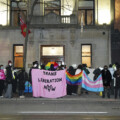If the Canadian public starts to wonder whether universities are providing value for money, social science and humanities departments ought to be nervous. Precarious provincial finances, coupled with the recently announced federal cap on international students, will inevitably put greater pressure on Canadian university budgets. Alongside less-than-stellar enrolment trends, there is increasing evidence of a lack of ideological diversity among these university faculty members, whose views are largely out of step with Canadian public opinion. Many in these departments seem to view their mission as “decolonizing the academy and embracing intersectional considerations” rather than producing knowledge or debate.
In Canada, these trends have crept into my own discipline of political science. In 2022, the Canadian Political Science Association approved an equity, diversity, inclusion, and decolonization mission statement that, among other things, emphasized the need to “resist and undo the forces of colonialism.”
More importantly, in October 2023 the new editors of the Canadian Journal of Political Science published a wide-reaching letter declaring their intention to “modernize the journal with a particular focus on addressing the legacy and ongoing effects of colonialism and systemic racism within the discipline.” They declared the journal was officially “committed to equity, diversity, inclusion, and decolonization in its content, methodological approaches, and governance.” Prospective authors are now questioned “if Equity, Diversity, Inclusion, and Decolonization has been considered” when they submit their papers. This esteemed political science journal had stated its intentions to make decolonization a central pillar of the publication going forward.

The Canadian Journal of Political Science is the flagship journal of the discipline in Canada. It describes itself as the “primary forum for innovative research on all facets of Canadian politics and government as well as the principal outlet for Canadian political science scholarship.” The journal has traditionally published a wide range of quantitative and qualitative content on all facets of Canadian political science, from elections to political theory.
As such, the new editors’ statement effectively accused the journal itself of contributing to discrimination: “In Canadian Political Science,” they wrote, “whiteness and white androcentric [male-centred] paradigms have served a gatekeeping function, keeping a body of diverse scholars and scholarship out of the core of the discipline.” According to the editors, this “gatekeeping” was not merely a relic of the past, but an ongoing sin of the present: “The backlash and resistance these scholars have faced and continue to face is often couched in assertions that their research is biased, not empirical, and lacking rigour.”
The new editors did not precisely specify which scholarship had been kept out of the discipline. But they were presumably referring to a broad range of “critical” and intersectional approaches that view politics, society, and academia as innately and structurally oppressive towards marginalized communities. Such scholarship is often criticized for its bias, lack of empirical rigour, and non-falsifiability. But the idea that it had been somehow excluded from the Canadian Journal of Political Science seemed to fly in the face of my experience as a peer reviewer and regular consumer of the journal’s content, who had already noticed an increasing amount of intersectionality in its pages.
Digging into the numbers
To determine if this was true, I conducted a content analysis of the abstracts of 227 papers—research articles, research notes, long-form review essays, brief “currents” pieces, and presidential addresses—published in issues of the Canadian Journal of Political Science between 2019-2023. (I excluded book reviews and the 24 brief pieces on COVID-19 that were published in a special section of the June 2020 issue). I reviewed the titles, abstracts, keywords, and, when necessary for the categorization described below, more detailed content in the papers themselves. The results of this analysis painted a very different picture than what the editors’ note suggested.
I first categorized each paper according to whether it contained some form of statistical or quantitative data collection and/or analysis—the most traditional form of “gatekeeping” in social science journals. I found that, while quantitative and statistical work remains prominent in the journal, it is by no means ubiquitous: 67 percent of all papers involved some form of quantitative data collection or analysis. Between 2019-2022 this percentage was roughly stable between 64-76 percent, though it dropped to 56 percent in 2023.
I also categorized each paper according to whether it had a major focus on marginalized communities—specifically, on race, women/gender, LGBTQ issues, and Indigenous Peoples. If, as the journal’s editorial board suggested, a “body of diverse scholars and scholarship” had been excluded from “the core of the discipline,” one would expect to find that research on marginalized communities was, well, marginalized. Yet this is not what I found. Fully 29 percent of papers published between 2019-2023 had a major emphasis on at least one of these marginalized communities (in 2023, it was 38 percent). A focus on Indigenous Peoples was most frequent: between 2019-2023, 14 percent of all papers published in the journal had a major focus on Indigeneity. This proportion was highest in 2023 when 19 percent of all papers (nine of 48) contained a major focus on Indigenous Peoples.
Overall, the journal contains no shortage of papers which have sought to address the “legacy and ongoing effects of colonialism and systemic racism” in political science. However, perhaps the new editors were arguing that the journal’s previous “gatekeepers” have only allowed papers on marginalized communities to be published if they included quantitative empirical content and avoided critical theory. If that were the case, one would expect papers focusing on marginalized communities would include roughly the same proportion of statistical data analysis as other papers.
Alas, this was not the case. Only 54 percent of papers with a major focus on marginalized communities contained quantitative data collection or analysis, compared with 73 percent of papers that did not focus on marginalized communities. Nearly all this variance can be explained by papers focusing on Indigeneity: only 31 percent of all papers in which Indigenous Peoples featured prominently involved some form of quantitative data collection or analysis (10 of 32), compared with 73 percent of papers in which Indigenous Peoples did not feature prominently. This trend continued apace in 2023, when only one of nine papers focusing on Indigenous Peoples (11 percent) contained some form of quantitative data, compared with 67 percent of non-Indigenous-focused papers (26 of 39).
There are many ways to interpret this data. One interpretation is that political science scholarship that focuses on marginalized communities, and Indigenous Peoples in particular, is simply less likely to require the rigorous use of data than scholarship on, say, elections or public opinion. There is likely some truth to this, though it does not fully explain why papers focusing on women/gender (78 percent) and the LGBTQ community (100 percent) had such high rates of data collection or analysis. Another interpretation could be that for certain forms of scholarship focusing on marginalized communities, reviewers and journal editors at the Canadian Journal of Political Science have reduced expectations that such research needs to involve the use of data. I have no special insight into whether either (or neither) of these interpretations is true. All I can say is that the journal editors’ accusation that gatekeepers have kept out diverse perspectives on the grounds of discriminatory empiricism is simply not supported by the data.
A closer look at the content within these papers also dispels the idea that the journal is a bastion of “white androcentric paradigms” keeping out marginalized voices. Each of the past four annual addresses from the president of the Canadian Political Science Association (published in the journal each year) contained a substantial focus on Indigenous Peoples. Over the last five years, the journal has published papers with titles such as “The Politics of White Identity and Settlers’ Indigenous Resentment in Canada,” “Trampling on Indigenous and Treaty Rights after R v. Stanley: ‘That’s What You Get for Trespassing,’” and “Decolonizing Research on the Carceral in Canadian Political Science.”
Authors have argued that non-Indigenous Canadians should “consider themselves ‘foreigners’ in need of invitation onto Indigenous lands,” that “the ability to engage in democratic activities is profoundly different depending upon which side of whiteness a person finds themself,” and that “a decolonized approach to studying the carceral [policing and prisons] must be relational and abolitionist, seeking to reduce and eliminate the use of carceral interventions.”

Moreover, when these critical perspectives are published, they are rarely (if ever) challenged. Of the 32 papers published in the Canadian Journal of Political Science between 2019-2023 in which the topic of Indigenous Peoples featured prominently, none involved anything that could be considered a critique of the “decolonization” narrative that runs through so much of Canadian academia.
Even in the quantitative work involving Indigenous Peoples published in the journal, scholars almost always include statements recognizing “the historic wrongs against Indigenous Peoples” or that it is “important to acknowledge the significant amount of invisible labour” that falls on “racialized and Indigenous faculty.” This is not to say that this scholarship is unworthy of publication, or that the sentiments expressed are not correct. It is only to say that these perspectives have not been marginalized. If anything, they are growing in salience. Far from being excluded from the discipline, authors engaging in what the journal’s editors referred to as “diverse” scholarship are publishing with greater frequency in the journal, without the expectation that the work must involve empirical data to ensure publication.
Conclusions
I draw three main conclusions. First, Canadian political science scholarship is clearly shifting in important ways. For better or worse, papers published in the Canadian Journal of Political Science reflect the discipline itself. While the discipline has not undergone a wholesale change (as seems to be the case in history), a sizeable proportion of Canada’s flagship political science journal is composed of papers using critical approaches and methodologies that place a greater emphasis on narratives of historical marginalization, particularly with respect to Indigenous Peoples and decolonization.
Second, the journal’s openness to critical methodologies and identity diversity has been accompanied by a narrowing of its ideological diversity. While authors’ policy recommendations are by no means ideologically homogenous, they generally range from centre-left to far-left. This tilt is most obvious in papers that focus on decolonization, but it is present throughout the entire journal. Of 227 papers published over the last five years, I did not find a single one that provided anything approximating a conservative policy recommendation. By contrast, even the journal’s most empirically rigorous quantitative papers often contain recommendations such as “political parties should recruit and promote more women candidates” and “Policy tools specifically designed to problematize, target and alleviate racial economic inequality also seem needed.” Conservative scholars used to publish mildly conservative policy recommendations in the journal. Those days are now long gone.
Third, the journal editors’ statement is sadly reflective of similar statements made in Canadian higher education regarding equity, diversity, and inclusion, insofar as it refuses to acknowledge any previous progressive change. The Canadian Journal of Political Science had already clearly opened itself up to diverse perspectives and methodologies in recent years. Several papers in a 2017 special issue had already identified some of these changes. Yet this did not stop its new editors from claiming that the discipline was still engaged in “gatekeeping” on behalf of “white androcentric paradigms.” Thankfully, political scientists are well-equipped to use data to test the truth of such speculative arguments.
In spite of the challenges facing our universities, Canadians continue to profess high levels of trust in academics, including those in the social sciences and humanities. To retain such trust, we must demonstrate a commitment to the core purposes of the university: intellectual curiosity and the pursuit of truth. We do ourselves no favours when we abandon these goals in favour of political projects.
Recommended for You

‘Our role is to ask uncomfortable questions’: The Full Press on why transgender issues are the third rail of Canadian journalism

Need to Know: Mark Carney’s digital services tax disaster

Theo Argitis: Carney is dismantling Trudeau’s tax legacy. How will he pay for his plan?

Kirk LaPointe: B.C.’s ferry fiasco is a perfectly Canadian controversy




